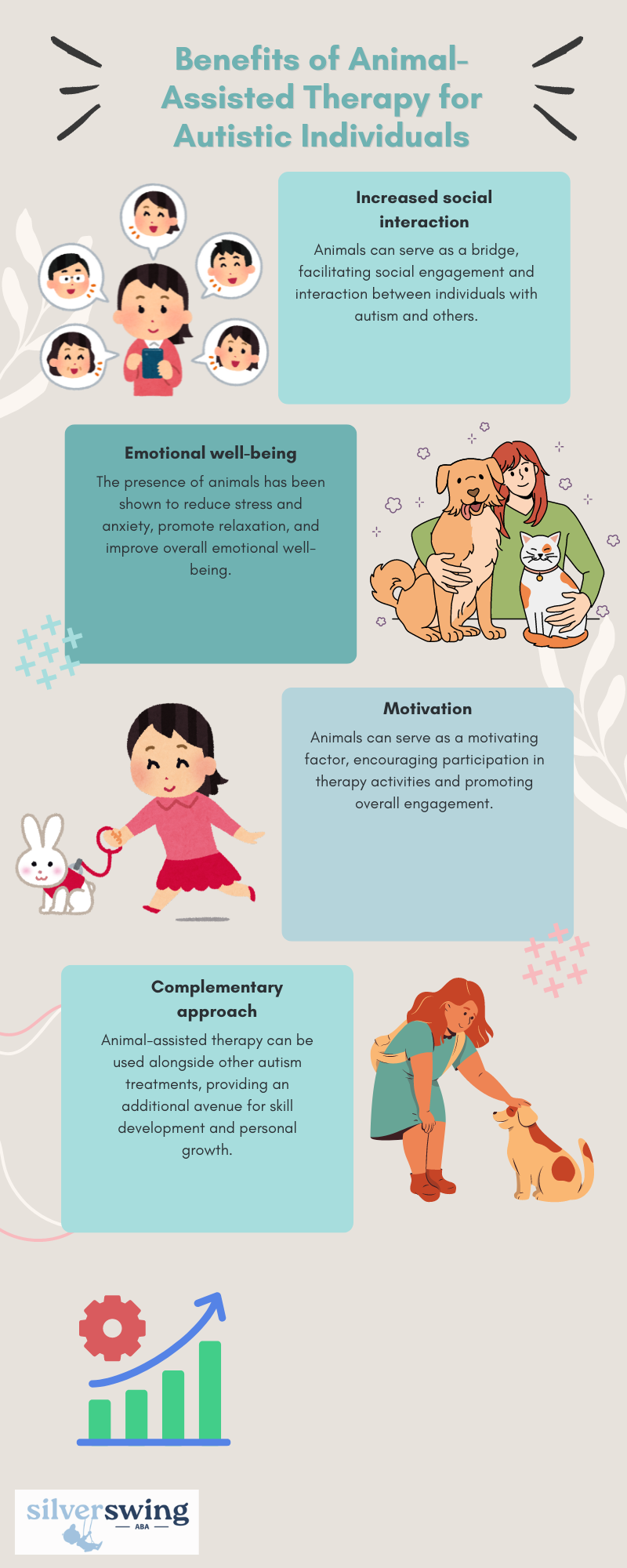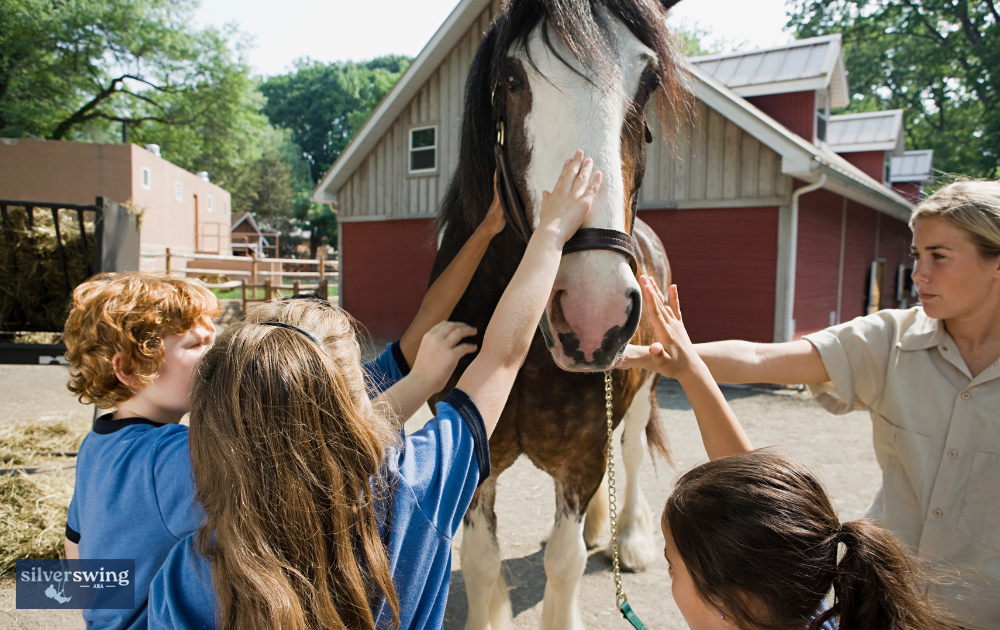Animal-assisted therapy has gained recognition as a valuable adjunctive approach in the treatment of autism spectrum disorder (ASD). By incorporating animals into therapeutic interventions, this form of therapy aims to enhance the well-being and social skills of individuals with autism.
Let’s take a closer look at the effectiveness of this practice.

The Role of Animal-Assisted Therapy
Animal-assisted therapy involves the deliberate inclusion of animals, particularly dogs, in therapeutic settings to facilitate therapeutic goals. While it is not recommended as a primary treatment option for autism, animal-assisted therapy can be a complementary or integrative treatment or enrichment activity. It is aimed at helping autistic individuals learn empathy, communication, and social skills.
It is important to note that animal-assisted therapy does not change the characteristics of autism itself.
In animal-assisted therapy sessions, trained animals and their handlers work alongside therapists, such as psychologists, speech pathologists, and occupational therapists. These professionals utilize animals as a means to engage and motivate individuals with autism, promoting emotional connection and interpersonal interactions.
Benefits and Limitations
Research on animal-assisted intervention for autism has expanded in recent years, shedding light on both the benefits and limitations of this therapy. It is important to understand that animal-assisted therapy is not a one-size-fits-all approach, and results may vary depending on the individual and their specific needs.
Some of the benefits of animal-assisted therapy for autism include:

However, it is important to note that it has its limitations as well. For one,animal-assisted therapy does not alter the core features of autism. It primarily focuses on improving specific skills and promoting emotional well-being.
Also, each individual with autism may respond differently to animal-assisted therapy. Some individuals may show significant benefits, while others may have a more limited response.
Finally, animal-assisted therapy is not recommended as a standalone treatment for autism but rather as a complementary approach to be used in conjunction with other evidence-based interventions.

Research on Animal-Assisted Interventions
Animal-assisted therapy has garnered significant attention in recent years, with an increase in high-quality research shedding light on its benefits and limitations for individuals with autism.
Let’s explore the various studies and findings related to animal-assisted interventions and their impact on social skills.
Studies and Findings
Numerous studies have been conducted to investigate the effectiveness of animal-assisted interventions for individuals with autism spectrum disorder (ASD).
One randomized study specifically focused on animal-assisted play therapy and its effects on social communication skills in children with ASD. The study found a significant improvement in social communication skills among the children who participated in animal-assisted play therapy compared to those who did not receive this form of therapy.
This finding highlights the positive impact that animal-assisted play therapy can have on the social skills development of individuals with ASD.
Other studies have also demonstrated the positive effects of animal-assisted interventions on autistic individuals. Pets, service dogs, and animal-assisted therapies have been shown to help individuals with autism cope with anxiety, engage more fully with others, and develop communication skills.
In fact, autistic individuals often display increased levels of smiling when they are in the presence of animals, indicating a positive impact on their emotional well-being.
Impact on Social Skills
Animal-assisted interventions have shown promise in improving social skills in individuals with autism. Dogs, in particular, are commonly used in therapeutic settings for children with ASD due to their social and affectionate nature. The presence of dogs can help children self-soothe, improve communication, and display more signs of interaction and attention.
Interacting with dogs can create a sense of comfort and companionship, which can be particularly beneficial for individuals with autism who may struggle with social interactions.
Equine-assisted therapy (EAT) is another form of animal-assisted intervention that has shown positive effects on individuals with ASD. EAT involves interaction with horses and has been found to be emotionally and socially beneficial for children with autism. This therapy helps improve low moods, develop motor skills, and enhance self-confidence. The presence of horses and the unique bond formed during equine-assisted therapy can contribute to the overall well-being and social development of individuals with ASD.
The research on animal-assisted interventions for individuals with autism highlights the potential of these interventions to positively impact social skills, emotional well-being, and overall quality of life. By incorporating animals into therapeutic settings, individuals with autism can experience improved social interactions, enhanced communication skills, and increased emotional connections.

Types of Animal-Assisted Interventions
Animal-assisted therapy offers a unique approach to supporting individuals with autism spectrum disorder (ASD). There are two common types of animal-assisted interventions for autistic individuals.
These are as follows:
Dog Therapy
Dogs are the most commonly used animals in therapeutic settings for children with ASD. Their social and affectionate nature can have a positive impact on individuals with autism. Dogs can help children with ASD self-soothe, improve communication skills, and show more signs of interaction and attention.
Service animals, such as dogs, can be trained to assist individuals with autism in various settings, including traveling, visiting the dentist or doctor, attending school activities, and other potentially stressful situations. These animals can help curb meltdowns, aggression, self-harm, and even provide protection for individuals with ASD who might wander off into danger.
The presence of a therapy dog can create a calming and comforting environment, reducing anxiety and stress levels. Interacting with a dog can also enhance social skills, as individuals with ASD may find it easier to engage with animals compared to humans.
Dogs in therapy can serve as non-judgmental companions, fostering emotional connections and promoting a sense of security.

Equine-Assisted Therapy
Equine-assisted therapy (EAT) involves interaction with horses and has shown to be beneficial emotionally and socially for children with ASD. Working with horses in a therapeutic setting can have a profound impact on individuals with autism, helping them improve their overall well-being.
Equine-assisted therapy can help children with ASD develop their motor skills, as activities involving horses often require coordination, balance, and body awareness. The rhythmic and repetitive motions of horseback riding can also have a calming effect, reducing stress and anxiety.
Additionally, equine-assisted therapy can help enhance self-confidence and self-esteem. The size and strength of horses provide individuals with ASD an opportunity to overcome fears and develop a sense of accomplishment. Building a bond with a horse can foster trust, empathy, and emotional regulation.
It’s worth noting that animal-assisted therapy should be conducted under the guidance of trained professionals who understand the specific needs of individuals with ASD. These professionals ensure the safety and effectiveness of the therapy sessions, tailoring them to meet the unique requirements of each individual.
By incorporating dogs and horses into therapy sessions, individuals with autism can experience the numerous benefits of animal-assisted interventions. Whether through the companionship of a therapy dog or the interaction with horses in equine-assisted therapy, animals play a valuable role in supporting individuals on the autism spectrum.
Effects of Animal-Assisted Therapy
Animal-assisted therapy, including interactions with pets, service dogs, and other animals, has shown positive effects on individuals with autism spectrum disorder (ASD).
Studies have demonstrated that animal-assisted therapy has a positive impact on the emotional well-being of individuals with autism. The presence of animals has been shown to help autistic individuals cope with anxiety, engage more fully with others, and develop communication skills.
Autistic individuals often exhibit increased smiling when in the presence of animals, indicating a positive emotional response. Pets and emotional support animals have been associated with measurable gains in social and communication skills, such as offering to share and offering comfort.
Animal-assisted therapy has also been found to have a significant positive impact on social interaction in individuals with autism. Research has shown that animal-assisted play therapy can lead to a notable improvement in social communication skills among children with ASD compared to those not receiving this therapy.
Dogs, known for their social and affectionate nature, are commonly used in therapeutic settings for children with autism. Interacting with dogs during therapy sessions helps children self-soothe, improve communication, and display more signs of interaction and attention.
Equine-assisted therapy (EAT) involving interaction with horses has also been found to be beneficial emotionally and socially for children with ASD. EAT helps improve low moods, develop motor skills, and enhance self-confidence.
The positive effects of animal-assisted therapy on emotional well-being and social interaction provide promising avenues for supporting individuals with autism. By incorporating animals into therapy sessions, individuals with autism can experience improved emotional regulation, increased social engagement, and enhanced overall well-being.




